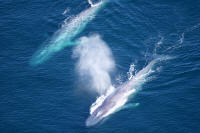Ship speed reduction lowered coastal air pollution
Environmental benefits also included less risk to whales
and ocean noise
 (VENTURA,
Calif. — April 4, 2024) Results from the 2023
Protecting Blue Whales and Blue Skies vessel speed
reduction (VSR) program show it reduced coastal California
air pollution, risk to whales and ocean noise.
(VENTURA,
Calif. — April 4, 2024) Results from the 2023
Protecting Blue Whales and Blue Skies vessel speed
reduction (VSR) program show it reduced coastal California
air pollution, risk to whales and ocean noise.
Participating companies reduced ship speeds off California,
transiting at 10 knots or less in the San Francisco and
Monterey Bay region and the Southern California region,
including Ventura County. The voluntary incentive-based
program ran from May 1 through December 15 with 33 global
shipping companies participating.
Results showed:
● Participants reduced their air pollutant emissions by
approximately 1,250 tons of nitrogen oxides (NOx) and 45,000
metric tons of regional greenhouse gases (GHG). This is a
27% reduction in NOx and GHG pollution from the
participating ships compared to 2016 baseline conditions.
The NOx reductions are equivalent to converting 800,000
passenger vehicles to zero emissions for a single year.
● The transits of participating vessels posed about 58% less
of a strike mortality risk to whales than if those vessels
did not reduce their speed.
● Ships in the qualifying performance tiers — with 35% or
more of fleet total distance in VSR zones traveled at 10
knots or less — had sound levels that were 5.4 decibels per
transit lower when compared to 2016 baseline source levels.
With a reduction in noise pollution, whales can likely
communicate easier.
● Ships in the program transiting the 200-nautical-mile VSR
zone in Southern California traveled at 10 knots or less for
83% of the total miles traveled. Cooperation has steadily
increased season after season, with about 21% of the miles
traveled in 2017 at 10 knots or less.
Automatic Identification System transponders on each ship
transmit speed and location. Data was analyzed for each
fleet.
Although 2023 was the first year that Protecting Blue Whales
and Blue Skies did not provide financial incentives,
participation and cooperation levels were the highest since
the program’s inception in 2014.
Container, car carrier, bulk and fuel carrier ships are
eligible to participate. The program complements the
National Oceanic and Atmospheric Administration (NOAA), U.S.
Coast Guard and Environmental Protection Agency voluntary
requests for all vessels 300 gross tons or larger to reduce
speeds during the months of peak air pollution and
endangered blue, humpback and fin whale abundance.
Ship strikes are a major threat to whales globally and to
the recovery of endangered whales in California waters.
Reducing the risk of ship strikes is a high priority for
NOAA’s West Coast national marine sanctuaries. Observed and
documented deaths off California totaled 52 endangered
whales from 2007 to 2022. This is thought to represent only
a small fraction of the total number of ship strikes taking
place annually.
The timing of the program coincides with the season when
ground-level ozone, or smog, concentrations are typically
high. The 10-knot target allows ships to travel safely and
at an efficient operating load using less fuel and producing
less pollution and regional greenhouse gas emissions.
Protecting Blue Whales and Blue Skies is a collaborative
effort by the Ventura County Air Pollution Control District
and several other air districts, national marine sanctuaries
in California, the California Marine Sanctuary Foundation
and other nonprofit organizations.
For more information, visit
www.bluewhalesblueskies.org.


 (VENTURA,
Calif. — April 4, 2024) Results from the 2023
(VENTURA,
Calif. — April 4, 2024) Results from the 2023